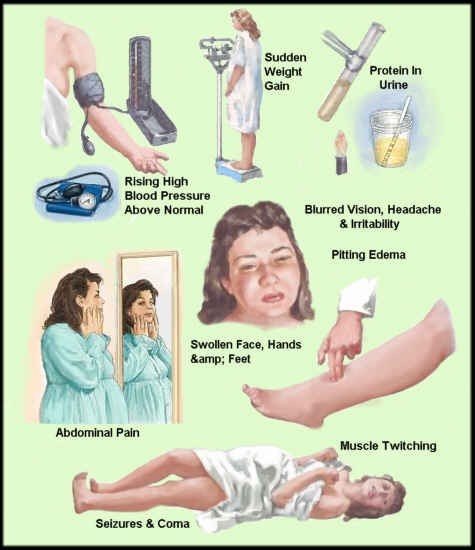During a routine prenatal visit at the antepartal clinic, a multipara at 35 weeks gestation presents with 2+ edema of the ankles and feet. Which additional information should the practical nurse (PN) report to the registered nurse?
Blood pressure.
Due date.
Fundal height.
Gravida and parity.
The Correct Answer is A
Edema, particularly if it is new or worsening, can be an indicator of preeclampsia, a potentially serious condition characterized by high blood pressure and organ dysfunction. Monitoring the client's blood pressure is crucial in assessing for signs of preeclampsia and determining the appropriate course of action.

B. Due date: The due date is an important piece of information for monitoring the progress of the pregnancy, but it is not directly relevant to the client's presenting symptom of edema. The focus should be on assessing for potential complications associated with edema, such as preeclampsia.
C. Fundal height: Fundal height is a measurement used to estimate fetal growth and position. While it is an important parameter to monitor during prenatal visits, it is not directly related to the client's edema. The priority in this situation is to assess for signs of preeclampsia or other complications, which may require assessing the blood pressure.
D. Gravida and parity: Gravida refers to the total number of pregnancies a woman has had, while parity refers to the number of pregnancies that have reached viability (20 weeks or more). While these pieces of information provide a background understanding of the client's obstetric history, they do not provide immediate insight into the current issue of edema. Assessing the blood pressure would be more relevant in this situation to identify any potential complications.
Nursing Test Bank
Naxlex Comprehensive Predictor Exams
Related Questions
Correct Answer is B
Explanation
While all of the options address the issue of impaired mobility related to fear of falling, the desired outcome of ambulating with assistance q4 hours is the most specific and measurable goal. This outcome focuses on promoting mobility and addressing the client's fear of falling by providing the necessary assistance during ambulation. It ensures that the client is engaging in regular activity and working towards regaining mobility.
The other options address different aspects of the nursing problem:
A. "The client will use self-affirmation statements to decrease fear" is a potential intervention that can be used to address the client's fear of falling, but it does not directly address the issue of impaired mobility.
C. "The physical therapist will instruct the client in the use of a walker" is an intervention that can be helpful in improving mobility, but it does not specify the frequency or timing of ambulation.
D. "The PN will place a gait belt on the client prior to ambulation" is a specific intervention that ensures the safety of the client during ambulation, but it does not address the frequency or timing of ambulation.
Correct Answer is D
Explanation
When the PN witnesses a situation where a resident is shouting profanities and a staff member (UAP) responds inappropriately, the immediate priority is to ensure the safety and well-being of the resident. It is essential to address the situation promptly and prevent further escalation.
Entering the room and instructing the UAP to leave immediately serves several purposes:
1. Protecting the resident: Removing the UAP from the room ensures that the resident is not subjected to further conflict or distress.
2. Maintaining a calm and therapeutic environment: By addressing the disruptive behavior and removing the staff member involved, the PN can help restore a peaceful environment for the resident and other individuals in the facility.
3. Ensuring professional conduct: Shouting and engaging in unprofessional behavior is not acceptable in a healthcare setting. By immediately intervening and directing the UAP to leave the room, the PN reinforces the importance of maintaining a respectful and professional approach to caregiving.
After addressing the immediate concern, the PN should follow up by reporting the incident and providing a detailed account to the nurse manager or supervisor. This allows for appropriate action to be taken, such as further investigation or disciplinary measures if necessary.
The other options mentioned are not the first actions to be taken in this situation:
A. Reporting the incident and the UAP for further action by the nurse manager: While reporting the incident is important, it is not the immediate action required to address the situation in
real-time.
B. Telling both of them to lower their voices in consideration of other residents: While promoting a calm environment is important, addressing the issue of shouting and unprofessional behavior takes precedence over requesting a volume reduction.
C. Telling the resident and the UAP that shouting is not permitted: While it is essential to communicate the expectations of behavior, the immediate focus should be on removing the staff member from the situation and ensuring the resident's well-being.
Whether you are a student looking to ace your exams or a practicing nurse seeking to enhance your expertise , our nursing education contents will empower you with the confidence and competence to make a difference in the lives of patients and become a respected leader in the healthcare field.
Visit Naxlex, invest in your future and unlock endless possibilities with our unparalleled nursing education contents today
Report Wrong Answer on the Current Question
Do you disagree with the answer? If yes, what is your expected answer? Explain.
Kindly be descriptive with the issue you are facing.
